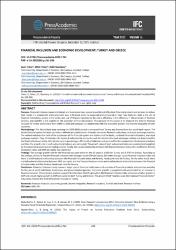| dc.contributor.author | Teker, Suat | en_US |
| dc.contributor.author | Teker, Dilek | en_US |
| dc.contributor.author | Güzelsoy, Halit | en_US |
| dc.date.accessioned | 2023-03-01T10:40:44Z | |
| dc.date.available | 2023-03-01T10:40:44Z | |
| dc.date.issued | 2023-02-01 | |
| dc.identifier.citation | Teker, S., Teker., D. & Güzelsoy, H., (2023). Financial inclusion and economic development: Turkey and Greece. PressAcademia Procedia, 16(1), 232-233. doi:10.17261/Pressacademia.2023.1704 | en_US |
| dc.identifier.issn | 2459-0762 | en_US |
| dc.identifier.uri | https://hdl.handle.net/11729/5400 | |
| dc.identifier.uri | http://dx.doi.org/10.17261/Pressacademia.2023.1704 | |
| dc.description.abstract | Purpose- Financial inclusion means individuals and businesses have access to useful and affordable financial products and services to deliver their needs in a responsible and sustainable way. A financial sector is measured and compared on four main features; debt is the size of financial institutions, access is the access and use of financial services by the users, efficiency is the efficiency in the provision of financial services, and stability is the stability in the provision of financial services. The purpose of this paper is to measure the level of financial inclusion of Turkey and Greece from 2000 to 2020 and compare its relationship with the economic growth and income inequality of both countries. Methodology- The World Bank data covering the 2000-2020 period is extracted from Turkey and Greece from the world bank report. The whole financial system for both countries is defined as a combination of banks, nonbanks financial institutions, and stock exchange markets. The related indicators for each of the subsectors of the financial system are determined for banks, nonbanks financial institutions, and stock exchange markets. Thus, 32 indicators for banks, 6 indicators for nonbanks, and 16 indicators for stock exchange markets are determined for the financial inclusion index. All indicators are in percentages. All individual indicators are summed for the computation of subsectoral indexes and then the growth rate in each subsectoral indexes are computed. The growth rates of each subsectoral index are summed and weighted by the subsectoral asset sizes or trading volüme. Finally, the causal relationship between the financial inclusion index, Gini coefficient, Poverty Headcount ratio, and GDP per capita was examined. Findings- The average growth rate for the financial inclusion index for the 21 years is 2,83% for Turkey and 0,97% for Greece. According to the analysis, we found that the financial inclusion index Granger-cause GDP per capita, Gini index Granger-cause financial inclusion index and there is a bidirectional relationship between the financial inclusion index and Poverty Headcount ratio for Turkey. On the other hand, there is a bidirectional relationship between GDP per capita and the financial inclusion index and a bidirectional relationship between the financial inclusion index and the Poverty Headcount ratio for Greece. Conclusion- Financial inclusion simply means a larger size of financial institutions and a variety of financial products and services available for the use of adult individuals, businesses, and governmental agencies. Economic growth is supported and accelerated by an increase in financial inclusion. The empirical analysis supports the literature that the growth in the financial inclusion index enhances a higher growth in GDP and a much higher growth in GDP per capita for both Turkey and Greece. The project titled “Istanbul as an International Financial Center” may easily improve the level of financial inclusion in Turkey. | en_US |
| dc.language.iso | en | en_US |
| dc.publisher | PressAcademia | en_US |
| dc.relation.ispartof | PressAcademia Procedia | en_US |
| dc.rights | info:eu-repo/semantics/openAccess | en_US |
| dc.subject | Financial inclusion | en_US |
| dc.subject | Economic growth | en_US |
| dc.subject | Income inequality | en_US |
| dc.subject | Financial indicators | en_US |
| dc.subject | Turkish and Greek financial markets | en_US |
| dc.title | Financial inclusion and economic development: Turkey and Greece | en_US |
| dc.type | Article | en_US |
| dc.description.version | Publisher's Version | en_US |
| dc.department | Işık Üniversitesi, İktisadi, İdari ve Sosyal Bilimler Fakültesi, İşletme Bölümü | en_US |
| dc.department | Işık University, Faculty of Economics, Administrative and Social Sciences, Department of Management | en_US |
| dc.authorid | 0000-0002-7981-3121 | |
| dc.authorid | 0000-0002-3893-4015 | |
| dc.authorid | 0000-0002-4600-4563 | |
| dc.authorid | 0000-0002-7981-3121 | en_US |
| dc.authorid | 0000-0002-3893-4015 | en_US |
| dc.authorid | 0000-0002-4600-4563 | en_US |
| dc.identifier.volume | 16 | |
| dc.identifier.issue | 1 | |
| dc.identifier.startpage | 232 | |
| dc.identifier.endpage | 233 | |
| dc.peerreviewed | Yes | en_US |
| dc.publicationstatus | Published | en_US |
| dc.relation.publicationcategory | Makale - Ulusal Hakemli Dergi - Kurum Öğretim Elemanı | en_US |
| dc.institutionauthor | Teker, Suat | en_US |
| dc.institutionauthor | Teker, Dilek | en_US |
| dc.institutionauthor | Güzelsoy, Halit | en_US |


















